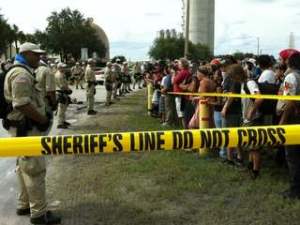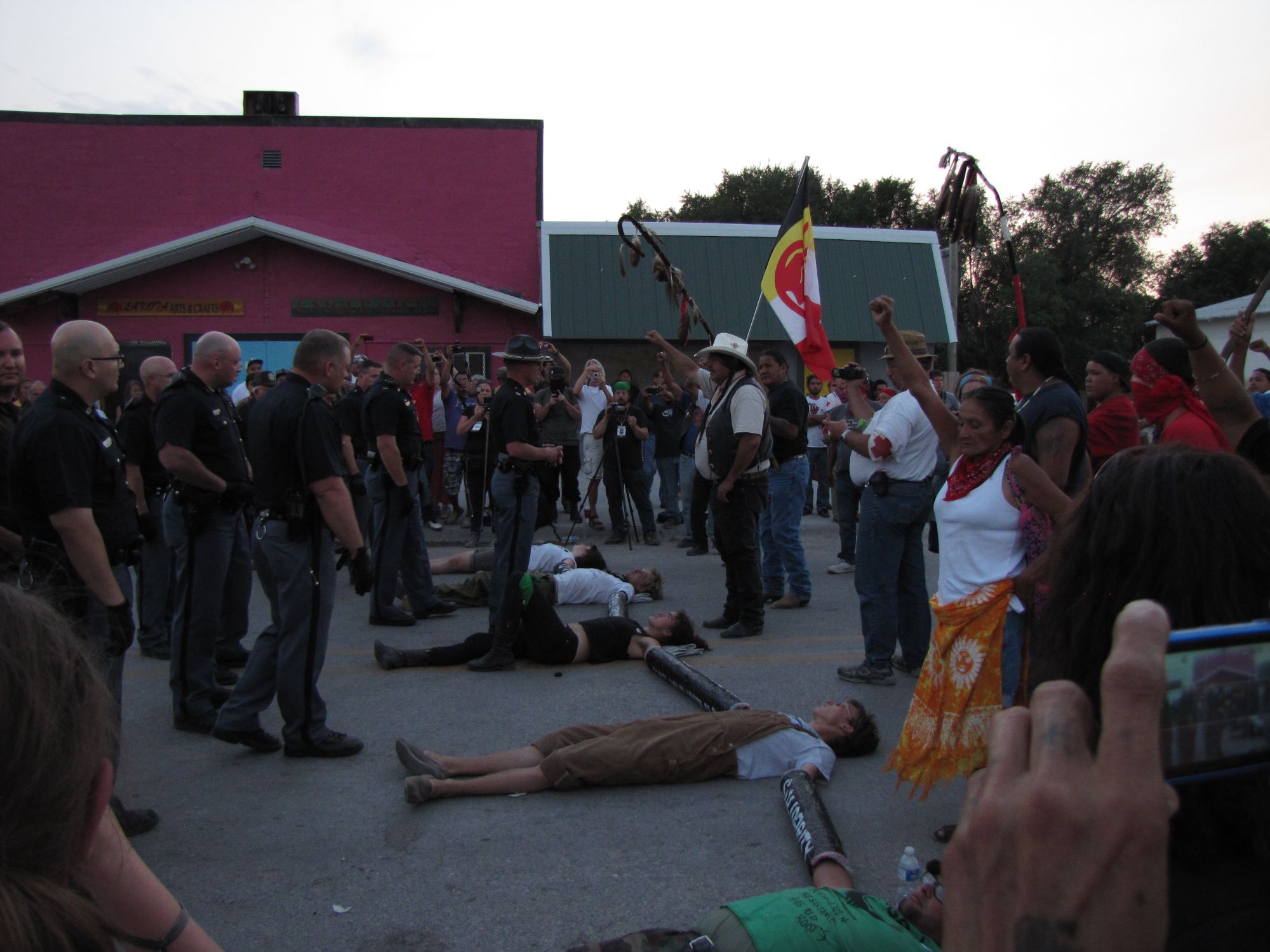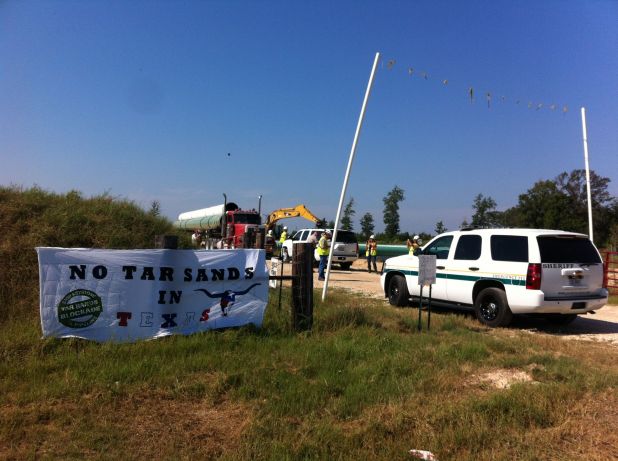by Deep Green Resistance News Service | Aug 31, 2012 | Indigenous Autonomy, Mining & Drilling, Obstruction & Occupation
By Skwekwekwelt Solidarity
Concerned members of the Tahltan Nation have set up a road block on Highway #37, 80 km south of Dease Lake, BC at the Tatogga Lake Resort. The Red Chris Mine is within the territory of the Tahltan Nation who have occupied territory since time immemorial. The specific area where the Red Chris Mine is being constructed is home to many species of animals including Stone Sheep, Mountain Goat, Moose and Caribou. The Tahltans depend upon these animals for subsistence and believe that the mine will destroy the animal’s habitat and calving grounds that is sacred to the Tahltans.
The Tahltan Leadership has spoken out strongly against the mine and criticized the BC mine permitting process that is viewed as corrupt. The BC Liberal Government has given free rein to mining companies leaving the environment vulnerable to contamination and disruption. Tahltans have serious concerns with the design of the tailings ponds and the potential for leakage and wide scale environmental disasters that will result should tailings leak into the environment. At the Tahltan Central Council Annual General Assembly held in July 2012 a resolution was passed to develop a No Red Chris Campaign to oppose the Red Chris Mining Project.
Two Tahltan women Kukdookaa and Adanza’a will be at the blockade with other elders and concerned Tahltans handing out information and educating those travelling along Highway #37 about the critical issues facing the Tahltans and their homelands.
Adanza’a is a 73 year old great grandmother on the blockade to protect her homeland for her grandchildren so that they can enjoy what we have today without the destruction mining will bring. She said that, “Our ancestors fought and died for our homeland to protect our way of life for us and the least we can do is fight for our rights and the rights of generations to come.”
Kukdookaa is also a grandmother who believes in fighting for the rights of the Tahltan Nation and will go to any length to protect the Tahltan people, wildlife, fish, and the environment. “It is irresponsible of the BC Government to provide permits while serious issues remain unresolved with the people who occupy the area.” Wild game outfitters, resort owners and other business people also have concerns with the location of the road and the disruption to wildlife and the pristine wilderness.
From Intercontinental Cry: http://intercontinentalcry.org/tahltans-set-up-roadblock-to-oppose-red-chris-mine/

by Deep Green Resistance News Service | Aug 31, 2012 | Obstruction & Occupation, Toxification
By Everglades Earth First!
In the climax of the 2012 Republican National Convention, protestors with Earth First! have blocked access roads to TECO’s Big Bend coal plant on the eastern shore of Tampa Bay. The environmental action group is citing corporate influence in politics and ecological impacts of fossil fuel dependency as reasons for the disruption.
This year’s RNC was funded by an estimated $55 million in corporate pay-offs, with corporations including the Tampa based-TECO Energy, along with Chevron, Duke Energy and Exxon Mobil.
According to a report by Natural Resources Defense Council (NRDC) last year, Florida is among the dirtiest states in power plant pollution. NRDC found TECO’s Big Bend plant to be in the state’s, “top three most polluting smoke stacks.”
Earth First! activists chose this day for their protest in order to highlight Mitt Romney’s plan to expand what the group calls the “energy empire” which favors the interest of big donors in oil, gas and coal industries.
Romney’s top energy policy advisor is the wealthiest oilman in the country and according to data analyzed by the Center for Responsive Politics, Romney has already raised more from mining interests than Bush or McCain raised from these industries in their entire campaigns.
Locally, TECO’s Big Bend plant has a long history of pollution. Along with being declared Florida’s number one dirtiest power plant by Florida Consumer Action Network, they were also documented discharging waste into Cobia Bay in Apollo Beach in years past.
But that’s not all. TECO has been called one of the nation’s worst offenders when it comes to mountaintop removal coal mining. In coal mining regions of the Appalachian Mountains, TECO has ruined entire communities to maximize their profits. Kentucky coalfield resident Doug Justice worked in the coal mines for 22 years and said “I have never seen an outfit treat a community the way TECO Coal has done us.”
In response to the devastation from floods caused be TECO’s mining in 2002, Granville Burke of Letcher County, Kentucky, had this to say: “I wish TECO had never started mining above our home. Protection for families like ours is supposed to come from the state and federal regulatory agencies, but instead they look the other way as coal companies destroy entire communities for the sake of profit.”
“Dirty energy becomes dirty politics. We can’t afford to stand by and watch it anymore. We have to fight back.” Said Rachel Kijewski, an organizer with the Earth First! movement in Florida.
From Earth First! Newswire: https://earthfirstnews.wordpress.com/2012/08/31/earth-first-blockades-coal-plant-at-rnc-in-tampa/#more-10126
by Deep Green Resistance News Service | Aug 30, 2012 | Climate Change
By Press Association
A vast reservoir of the potent greenhouse gas methane may be locked beneath the Antarctic ice sheet, a study suggests.
Scientists say the gas could be released into the atmosphere if enough of the ice melts away, adding to global warming.
Research indicates that ancient deposits of organic matter may have been converted to methane by microbes living in low-oxygen conditions.
The organic material dates back to a period 35m years ago when the Antarctic was much warmer than it is today and teeming with life.
Study co-author Prof Slawek Tulaczyk, from the University of California at Santa Barbara, said: “Some of the organic material produced by this life became trapped in sediments, which then were cut off from the rest of the world when the ice sheet grew. Our modelling shows that over millions of years, microbes may have turned this old organic carbon into methane.”
Half the West Antarctic ice sheet and a quarter of the East Antarctic sheet lie on pre-glacial sedimentary basins containing around 21,000bn tonnes of carbon, said the scientists, writing in the journal Nature.
British co-author Prof Jemma Wadham, from the University of Bristol, said: “This is an immense amount of organic carbon, more than 10 times the size of carbon stocks in northern permafrost regions.
“Our laboratory experiments tell us that these sub-ice environments are also biologically active, meaning that this organic carbon is probably being metabolised into carbon dioxide and methane gas by microbes.”
The amount of frozen and free methane gas beneath the ice sheets could amount to 4bn tonnes, the researchers estimate.
Disappearing ice could free enough of the gas to have an impact on future global climate change, they believe.
“Our study highlights the need for continued scientific exploration of remote sub-ice environments in Antarctica because they may have far greater impact on Earth’s climate system than we have appreciated in the past,” said Prof Tulaczyk.
The Antarctic ice sheet covers the southern continent’s land mass and not the sea around it. Methane hydrates – a combination of frozen water ice and methane – are also found at the bottom of the oceans where they form as a result of cold temperatures and high pressures.
From The Guardian: http://www.guardian.co.uk/environment/2012/aug/29/antarctica-methane

by Deep Green Resistance News Service | Aug 29, 2012 | Colonialism & Conquest, Indigenous Autonomy
Mujeres de la nación Oglala Lakota, junto con activistas de Resistencia Verde Radical, AIM Grassroots, Movimiento Nativo Juvenil, Un-Occupy Albuquerque, Occupy Lincoln, y el Centro de Paz y Justicia Rocky Mountain participaron en una marcha desde Billy Mills Hall en Pine Ridge hasta White Clay para protestar contra la industria depredadora de bebidas alcohólicas que está presente allí.
White Clay tiene, para una población de 14 personas, 4 tiendas de bebidas alcohólicas en el pueblo que venden 12,500 latas de cerveza cada día. Las tiendas han sido investigadas varias veces por haber vendido a vendedores ilegales, personas embriagadas, menores y tambien a cambio de favores sexuales.
“Durante más de 100 años las mujeres de la nación Oglala Lakota han hecho frente a un ataque a los mentes, a los cuerpos y a los espíritus de sus parientes”, dice Olowan Martinez, un organizador principal del evento y residente de Pine Ridge. “La Oglala han sido callados mediante la guerra química por parte de las corporaciones que explotan y se benefician del sufrimiento y de la miseria de nuestra gente. El tiempo ha llegado para terminar este sufrimiento por todos los medios necesarios.
Debra White Plume, una activista Lakota y residente de Pine Ridge habló durante el evento y proclamó, “Una indígena sobria es una indígena peligrosa. Tenemos que mandar un mensaje a Nebraska y a sus ciudadanos de que no vamos a tolerar los asuntos tal como están. Este es el Día de Paz de las Mujeres pero esta paz acabará pronto.”
Después de la marcha y de los discursos de los miembros de Resistencia Verde Radical, se hizo un bloqueo del camino hacia White Clay.
Media hora después de que el bloqueo comenzara, un agente policial bajó su ventanilla del coche y sin discriminación roció a la multitud con gas pimienta. Hasta 12 personas fueron rociados, incluyendo al hijo de 10 años de una mujer Lakota que ayudó a organizar la marcha. Tambien una anciana mujer Lakota, Helen Red Feather, denunció que su pierna fue golpeada por un coche policial. Médicos en la protesta trataron a las heridas producidas por el gas pimienta.
A las 7:39, los cinco activistas que participaron en el bloque fueron llevados en un remolque de caballos a la cárcel del distrito de Sheridan en Rushville. Después fueron liberados bajo su propia tutela.
Hoy en día falta mucho para que la justicia se cumpla, como en White Clay se sigue destruyendo a los Lakota Oglala y a la gente de Pine Ridge. La Oglala Lakota de la reservación Pine Ridge seguirán presos mientras las tiendas de bebidas alcohólicas en White Clay sigan funcionando.
Las consignas de “Tanto como dure!” fueron coreadas por la gente y por las personas que las apoyaban, de pie junto a ellas desde el comienzo de la protesta. La lucha continua.
Para más información sobre El Dia de Paz y La Marcha de Mujeres, y para fotos de la acción, visita a http://dgrnewsservice.org/2012/08/26/womens-day-of-peace-action-in-white-clay/
Quiere ayudar en la acción? http://deepgreenresistance.org/feature-help-support-indigenous-solidarity-in-whiteclay/
For the English version of this article, see http://dgrnewsservice.org/2012/08/26/womens-march-and-day-of-peace-turns-violent-protesters-arrested/

by Deep Green Resistance News Service | Aug 28, 2012 | Obstruction & Occupation
By Tar Sands Blockade
Just minutes ago four landowner advocates and climate justice organizers locked themselves to the underside of a massive truck carrying 36″ pipe intended for Keystone XL construction. The truck is parked, idled at the entrance of the pipeyard, rendering construction activity impossible. Seven blockaders total are onsite risking arrest. Blockaders from the Red River valley to the Gulf Coast and beyond have united to realize their collective vision of a world without toxic tar sands pipelines. Today’s message is clear: the people are rising up to defend their homes.
This act of peaceful civil disobedience comes in the wake of a recent court decision condoning TransCanada’s use of eminent domain for private gain. Last week Lamar County Judge Bill Harris ruled in a shockingly abbreviated fifteen-word summary judgment that Texas farmer Julia Trigg Crawford cannot challenge TransCanada’s claim that it is entitled to a piece of her home. The underwhelming ruling was emailed to Ms. Crawford’s attorney late in the evening of August 15 from the Judge’s iPhone.
The arrogant disregard levied at landowners like Julia Trigg Crawford for simply not consenting to have a tar sands pipeline permanently bisect their homes is what motivated Houston businessman Ray Torgerson to take action with the Blockade. “The fact that this corporation can check a box on a form and steal someone’s land is insulting,” Ray says. “We are here to defend our homes and stand with landowners like Julia.”
Further emblematic of the disrespect small town families like the Crawfords have faced throughout Keystone XL legal proceedings, Ms. Crawford received first notice of the ruling from a reporter seeking comment who had been blind carbon copied on the County Judge’s email ruling.
“It was heartbreaking to hear a generational family farm like the Crawford’s can be taken away by a multinational corporation,” exclaims blockader Audrey Steiner, a linguistic anthropologist from Austin. “I’m here to change the direction our country is taking.”
The concerns of the blockaders today go well beyond TransCanada’s appalling contempt for property rights. As Tammie Carson, a lifelong Texan living in Arlington explains, “I’m doing this for my grandchildren. I’m outraged that multinational corporations like TransCanada are wrecking our climate. The planet isn’t theirs to destroy, and I’m willing to take a risk to protect my grandchildren’s future.”
Denny Hook, a retired minister from Gainesville, Texas, describes himself as “An environmentalist that happens to be a minister.” In taking action today, Hook hopes to inspire more people to join the movement. “Things are so dire that if all of us don’t rise up we won’t make it. This pipeline is the difference between Earth on the edge and Earth over the edge.”
Tar Sands Blockade is a coalition of Texas and Oklahoma landowners and climate organizers using peaceful and sustained civil disobedience to stop the construction of Keystone XL.
“The blockade is an expression of people who have spent years using every available avenue afforded to them, and nothing has worked,” explains Tar Sands Blockade spokesperson Ron Seifert. “The urgency of this crisis is galvanizing supporters who understand that doing nothing involves a greater risk than taking action.”
From Tar Sands Blockade: http://tarsandsblockade.org/press/press-releases/



